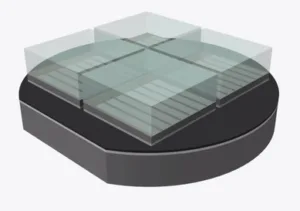Korea’s display industry, led by Samsung Display and LG Display, has unveiled an ambitious plan to invest over 65 trillion won ($49 billion) by 2027 in a bid to reclaim the top spot in the global display market from China. The strategy, announced at the Display Industry Innovation Strategy Roundtable, hosted by the Korean Ministry of Trade, Industry and Energy (MOTIE), aims to increase Korea’s global market share to 50% and widen the technology gap with competitors by more than five years.\
Business Korea is reporting that MOTIE presented the plan at the roundtable, attended by industry officials and government representatives, including MOTIE Minister Lee Chang-yang, Samsung Display CTO Kim Sung-chul, LG Display CTO Yoon Soo-young, and Samsung Electronics Vice President Kim Yong-jae.
Korea, which had maintained its position as the world’s top display industry for 17 years, was overtaken by China in 2021 due to the latter’s rapid growth in the liquid crystal display (LCD) sector. China accounted for 42.5% of the global display market last year, while Korea held a 36.9% share, according to the Korea Display Industry Association.
To regain its dominance, the Korean display industry plans to invest in expanding production lines for organic light-emitting diode (OLED) panels, with a particular focus on information technology (IT) applications. Additionally, research and development efforts for next-generation displays will be intensified. The objective is not only to recapture the top spot but also to significantly extend the technology gap with competitors to more than five years.
The Korean government aims to facilitate these investments by providing support through tax incentives, policy finance, and infrastructure improvements. The recently enacted K-Chips Act raised the tax credit rate for display facility investments, and policy finance of 900 billion won has been made available for new investments through financial institutions.
Regulatory reforms and the designation of specialized display complexes are part of the government’s strategy to create a favorable business environment. Streamlining safety inspections for hazardous chemicals and promoting the localization of critical components are key measures that will be implemented.
Investing for Dominance: The Inorganic LED Strategy
The Korean display industry also plans to invest in the research and development of inorganic light-emitting display (iLED) technology to stay ahead of competitors. By conducting a large-scale feasibility study and establishing the iLED Industry Development Alliance, Korea aims to maintain a significant technological advantage in terms of brighter, longer-lasting, and larger screens.
One fundamental difference between inorganic LEDs (iLEDs) and organic LEDs (OLEDs) lies in the materials used for light emission. While iLEDs employ inorganic semiconductors, such as gallium nitride (GaN) or silicon carbide (SiC), OLEDs utilize organic compounds, typically carbon-based molecules, as the active light-emitting materials.
This distinction in materials leads to several contrasting characteristics between iLEDs and OLEDs. Firstly, iLEDs tend to exhibit higher efficiency than OLEDs. Inorganic semiconductors have excellent quantum efficiency, enabling them to convert a significant portion of injected electrical energy into light output. This efficiency is attributed to the direct recombination of charge carriers within the inorganic semiconductor’s crystal lattice.
Additionally, iLEDs have superior longevity compared to OLEDs. Inorganic materials are more resilient and less prone to degradation factors such as moisture, oxygen, and heat, which can deteriorate the performance and lifespan of OLEDs. As a result, iLEDs are better suited for applications that demand prolonged operational lifetimes, such as lighting fixtures or displays in commercial or industrial settings.
Furthermore, iLEDs are capable of achieving higher brightness levels than OLEDs. The characteristics of inorganic semiconductors, coupled with advanced epitaxial growth techniques, enable iLEDs to generate intense illumination suitable for various applications requiring high luminosity. On the other hand, OLEDs may have limitations in achieving extremely high brightness levels due to the properties of organic materials.
It’s important to note that while iLEDs offer advantages in terms of efficiency, longevity, and brightness, OLEDs possess their own strengths. OLEDs excel in areas such as thinness, flexibility, and the ability to produce self-emitting pixels, which can lead to exceptional contrast ratios and vibrant colors. These qualities make OLEDs well-suited for applications such as thin, flexible displays and lighting panels where design versatility is critical.
Korean Display Industry to Hire 9,000 Engineers Over Next Decade
Strengthening the supply chain is another crucial aspect of the strategy. Korea aims to increase its self-sufficiency ratio in materials, parts, and equipment from the current 65 percent to 80 percent. Localization efforts will be supported, especially for small businesses operating in sectors such as fine metal masks, exposure machines, and packaging equipment.
The Korean government also aims to tap into emerging display markets to drive future growth. Transparent displays, extended reality (XR) displays, and automotive displays are identified as sectors with significant potential. Over the next five years, a budget of 74 billion won has been allocated to promote the development of these markets.
Recognizing the importance of skilled human resources, the public and private sectors will collaborate to train 9,000 talented engineers over the next decade. Panel companies will play a crucial role in nurturing these professionals through recruitment-linked contracting departments. The government will establish specialized graduate schools and introduce new undergraduate majors to cultivate master’s and doctoral manpower.
With its comprehensive strategy in place, the Korean display industry is determined to reclaim its position as the global leader. Through substantial investments, technological advancements, supply chain strengthening, and market diversification, Korea aims to regain its No. 1 position in the global display industry by 2027.

